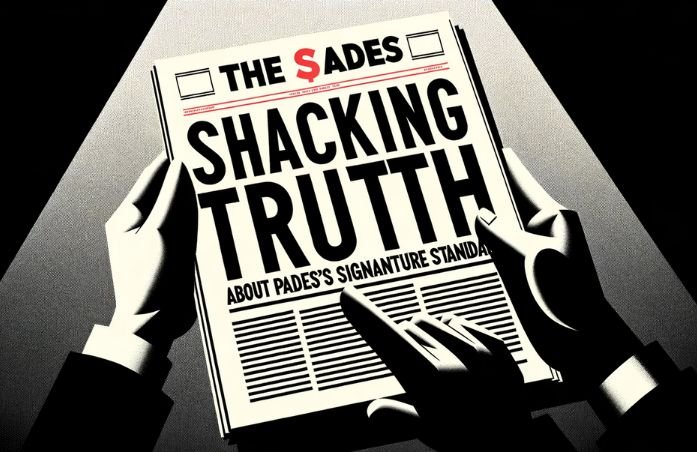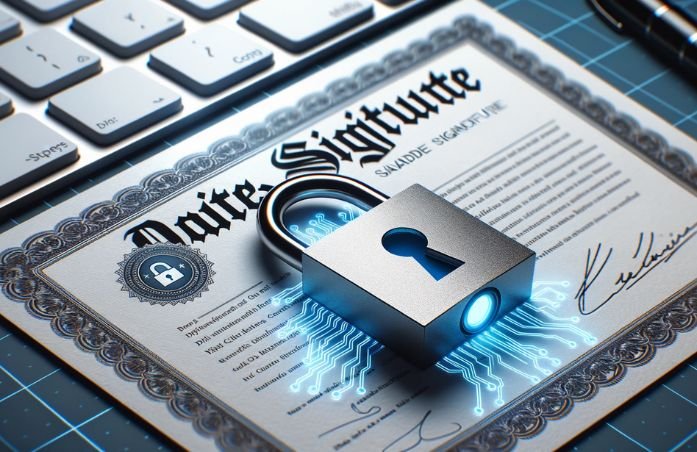PAdES Signature: Ensuring Document Integrity and Security
Imagine a world where important documents could be easily tampered with or forged, putting businesses and individuals at risk of fraud and deception. Thankfully, with the advent of PAdES signature technology, that world is becoming a thing of the past. In this article, we will explore the significance of PAdES signatures in ensuring document integrity and security. From digital contracts to confidential reports, PAdES has revolutionized how we verify the authenticity of electronic documents. Join us as we delve into the inner workings of this powerful tool and discover how it can protect your information from falling into the wrong hands.

The Power of PAdES Signature: An Overview
PAdES signatures enhance the security and integrity of digital documents, ensuring legal validity and compatibility with various platforms, making them an ideal choice for organizations moving towards digitization.
- 📃 PAdES signatures provide integrity and security for digital documents.
- 🔐 Specifically designed for PDF files to prevent tampering.
- 📜 Cryptographic algorithms generate a unique digital fingerprint.
- 📋 Compatible with various platforms and software applications.
- 📜 Adheres to international standards like the EU’s eIDAS regulation.
- 🖋️ Offers legal validity equivalent to handwritten signatures.
- 💼 Ideal for enhancing document integrity and streamlining workflows.
PAdES Signature: A Digital Safeguard
PAdES signatures use advanced cryptographic techniques to ensure document integrity and security, embedding multiple layers of security measures within digital documents for tamper-evident and secure verification
- 📄 PAdES, or “PDF Advanced Electronic Signatures,” ensures document integrity and security.
- 🔒 Utilizes the widely used PDF format for document sharing and archiving.
- 📜 Incorporates advanced cryptographic techniques for authenticity and integrity.
- 🛡️ Embeds multiple layers of security within digital documents.
- 💼 Verifies signer identity and protects against tampering.
- 🖋️ Signature is tamper-evident and highly secure.
- 📰 PAdES is a standardized framework for electronic document verification and signing.

Why PAdES Matters
PAdES Signature is essential for various reasons, primarily for ensuring document authenticity, integrity, and confidentiality. It is especially critical in industries like legal, finance, and healthcare, where sensitive information is frequently exchanged.
By using PAdES Signature, organizations can have confidence in the authenticity of electronic documents. This signature ensures that the document has not been tampered with or altered since it was signed, providing a level of trust and assurance.
Furthermore, PAdES Signature helps maintain the integrity of documents by preventing unauthorized modifications. Any changes made to a digitally signed document will invalidate the signature, alerting recipients to potential tampering attempts.
Confidentiality is also a significant concern when handling sensitive information. With PAdES Signature, data remains secure and confidential, as the technology employs advanced encryption techniques to protect against unauthorized access.
Understanding the PAdES Signature Process
Understanding the PAdES signature process involves knowing its core components, the embedding of additional information, and how it enhances document security, making it vital for businesses in today’s digitized landscape.
- 📜 PAdES, or PDF Advanced Electronic Signatures, ensure document integrity and legal validity.
- 📑 Core components of a PAdES signature include the document, signer’s certificate, and cryptographic algorithms.
- 🕰️ PAdES can embed additional information, such as timestamps, within the signature.
- 📃 Ensures ongoing verification, even if certificates expire or are revoked.
- 📊 Understanding PAdES helps enhance document security and streamline workflows.
- 🖋️ Digital signatures provide non-repudiation and provable integrity.
- 💼 Crucial for remote work and paperless operations in the digital landscape.

The PAdES Signature Process: Ensuring Document Integrity and Security
The PAdES signature process ensures document integrity and security by converting documents into PDF format, generating unique fingerprints, encrypting them, and adding trusted timestamps, establishing confidence in electronic transactions.
- 📜 PAdES signature process ensures document integrity and security.
- 📄 Documents are converted to PDF format for broad compatibility.
- 🖋 Cryptographic processes generate a unique digital fingerprint or hash value.
- 🔐 Encryption using the signer’s private key enhances security.
- 🕰️ A trusted timestamp authority may add an official timestamp for authenticity.
- 💼 Understanding each step is crucial for appreciating the process’s significance.
- 📃 PAdES signatures establish confidence in electronic transactions and protect against tampering and forgery.
Document Creation: The Foundation of Integrity and Security
The document is prepared in a PDF format, which is one of the most commonly used formats for document creation today. Portable Document Format (PDF) files are widely recognized and accepted for their ability to retain formatting across different operating systems and devices. This makes them an ideal choice for creating and sharing documents that need to maintain their integrity.
PDF documents offer a range of features that enhance their security, such as password protection and encryption. These measures ensure that only authorized individuals can access the content of the document, protecting it from unauthorized alterations or copying. Additionally, PDFs allow for the inclusion of digital signatures, providing a way to authenticate the origin and integrity of the document.
When creating a PDF document, it’s crucial to consider its future use and potential need for verification or signing. By utilizing features like PAdES (PDF Advanced Electronic Signatures), document creators can ensure not only the security but also the legal validity of their files. PAdES provides an internationally recognized standard for digital signatures within PDFs, offering a high level of assurance in terms of both authenticity and integrity.
Adding Signature Fields: Empowering Digital Signatures
Digital signature fields are an essential feature when it comes to ensuring document integrity and security. By adding these fields to the document, users can easily sign and verify the authenticity of the data within. One of the key advantages of digital signature fields is the ability to detect any tampering or modifications made to the document after it has been signed. This not only guarantees that the original content remains intact but also provides a level of trust between parties involved in the document exchange.
Moreover, digital signature fields offer convenience by eliminating the need for physical paperwork and long processing times. With just a few clicks, users can sign documents electronically without having to print, scan, or physically deliver them. This greatly reduces administrative tasks and speeds up business processes. Additionally, by adding multiple signature fields in a document, different parties can sign separately, allowing for a streamlined workflow that saves time and increases productivity.
Furthermore, digital signature fields provide increased security through encryption techniques. These encryption methods ensure that only authorized individuals have access to sensitive information within the document. It not only protects confidential data from unauthorized viewing but also prevents any alterations or unauthorized modifications of the content.
In conclusion, adding digital signature fields to documents brings numerous advantages such as preserving document integrity and security by detecting tampering attempts, providing convenience through electronic signing processes that eliminate physical paperwork, facilitating collaboration with multiple signatures in one document for efficient workflows, and enhancing overall security through encryption techniques that safeguard sensitive information. In today’s fast-paced world efficiency and trust are paramount concerns during online transactions.

Signing the Document: The Key to Document Integrity
Digital signatures using private keys ensure document integrity, establish identity with confidence, and streamline processes while providing trust and reliability in various industries.
- 📜 Signing a document is crucial for authenticity and integrity.
- 🖋 Digital signatures using private keys provide efficiency and security.
- 🔐 A unique cryptographic hash is created and encrypted with the private key.
- 🌐 This encrypted hash acts as a tamper-evident fingerprint.
- 💼 Digital signatures offer non-repudiation, establishing identity with confidence.
- 💳 Trust and reliability in industries like finance and legal services.
- 📊 Streamlines processes, ensuring authentication and verification.
- 🌍 Offers efficiency and safeguards against unauthorized changes.
Verification: Ensuring Document Authenticity
One of the key advantages of using PAdES signatures for document integrity is the ability to verify the authenticity of the signature. By digitally signing a document, the signer adds an encrypted code that serves as a unique identifier. This digital signature can then be verified by recipients using various verification tools and algorithms.
In addition to verifying the authenticity of a signature, PAdES signatures also provide protection against tampering. The digital signature is linked to the content of the document, and any alteration made after signing will invalidate the signature. Recipients can easily check if a document has been tampered with by comparing its current state with its original signed version.
The verification process goes beyond merely confirming that a signature matches a specific digital certificate or key; it ensures that both intended and unintended modifications to the document are detected. This provides an added layer of security for sensitive documents, giving peace of mind to users that their content remains unchanged from when it was initially signed.
PAdES Signature vs. Basic Electronic Signatures: The Difference in Security
PAdES Signature is often compared to basic electronic signatures. While basic signatures offer a level of security, PAdES takes it a step further by ensuring long-term document integrity and legality. It complies with strict regulatory standards and is recognized in many countries.
This added layer of assurance is achieved through the use of advanced cryptographic techniques. PAdES signatures not only verify the authenticity of the signer but also protect against any tampering or alterations to the document after it has been signed.
One key advantage of PAdES over basic electronic signatures is its compatibility with different file formats, such as PDF (Portable Document Format). This makes it a versatile solution for businesses and organizations that frequently deal with documents in various formats.
Legal Validity: The Backbone of Trust
One of the critical benefits of PAdES is its legal validity. In many jurisdictions, PAdES signatures are equivalent to handwritten signatures, making them legally binding. This is vital for contracts and agreements that need to be signed electronically. PAdES follows stringent requirements and standards set by various regulatory bodies, ensuring that the signed documents are admissible in court and hold the same legal weight as traditional handwritten signatures.
Additionally, PAdES provides a robust level of security that further enhances its legal validity. The digital signature created using PAdES incorporates cryptographic algorithms to encrypt the document and authenticate the signer’s identity. This ensures that the integrity of the document remains intact, preventing any unauthorized modifications or tampering.
Advanced Encryption: The Shield Against Unauthorized Access
PAdES uses advanced encryption techniques to protect the document from unauthorized access or modification. This encryption ensures the confidentiality of sensitive data.
In addition to confidentiality, Advanced Encryption PAdES also provides integrity protection for the document. This means that any unauthorized modifications or tampering of the document will be detected.
The encryption process involves converting the original document into an unreadable format using a complex algorithm. Only authorized individuals with the decryption key can unlock and access the contents of the encrypted document.
Furthermore, Advanced Encryption PAdES supports strong encryption algorithms such as AES (Advanced Encryption Standard) and RSA (Rivest-Shamir-Adleman), providing an extra layer of security for documents that need to remain confidential and tamper-evident.

Implementing PAdES Signature: Choosing the Right Path to Document Integrity
To implement PAdES Signature, you need suitable software. Several trusted options are available, such as Adobe Acrobat and specialized e-signature solutions.
These software options offer different features and functionalities, so it’s important to choose one that aligns with your specific needs and requirements. Adobe Acrobat is a widely used software that provides comprehensive PDF capabilities, including PAdES signature functionality.
Adobe Acrobat allows users to create, sign, and validate PAdES signatures easily. It offers a user-friendly interface with intuitive tools for adding digital signatures to PDF documents. Additionally, it supports various signature formats and encryption methods required for PAdES compliance.
Alternatively, you can explore specialized e-signature solutions that cater to your organization’s unique needs, providing a seamless experience for implementing and verifying PAdES signatures.
Setting Up Signature Fields: The Foundation for Secure Signatures
Once you have the software in place, you can start adding digital signature fields to your document. These fields act as placeholders for the signatures.
To begin setting up signature fields, open your document in the software you are using. Look for an option or tool that allows you to add form fields or annotations.
Select the appropriate type of signature field from the available options. This could be a simple text box where signers can type their names, or a more advanced field that captures an image of their actual handwritten signature.
Click on the area of the document where you want to place the signature field. A placeholder will appear indicating where the signer should place their signature. This step empowers signers to easily add their signatures while ensuring that they are signing in the right place.
Digital Signing: The Process of Trust and Verification
The verification process involves checking the PAdES Signature to confirm document integrity, signer identity, and that the document hasn’t been tampered with during transit.
- 🔒 Signing the document with a private key ensures authenticity.
- 📜 Recipients can verify the document through the PAdES Signature.
- 📊 Verification confirms document integrity and signer identity.
- 📰 The process involves comparing the digital signature with the public key.
- 🧰 Various software or tools support PAdES signature verification.
- 🕵️♂️ Tools extract and analyze information from the signature and document.
- 🛡️ They check for any alterations or modifications to the document.
- 🔄 Attributes and cryptographic data are compared to ensure authenticity.
PAdES Signature FAQs: Your Guide to Document Security
- What is the difference between PAdES and other electronic signatures?
PAdES offers advanced security features and legal validity that many basic electronic signatures lack. It focuses on long-term document integrity and is legally recognized in various jurisdictions.
- Is PAdES Signature suitable for all types of documents?
Yes, PAdES Signature is versatile and can be used for various types of documents, including contracts, invoices, and legal agreements.
- Do I need specialized software for PAdES Signature?
Yes, you need software capable of creating and verifying PAdES signatures. Adobe Acrobat and dedicated e-signature solutions are popular choices.
- How does PAdES Signature protect against document tampering?
PAdES Signature uses advanced encryption techniques to ensure the document’s confidentiality and protect it from unauthorized alterations.
- Is PAdES Signature legally binding?
Yes, in many countries, PAdES signatures are legally binding and equivalent to handwritten signatures.
- Can PAdES Signature be used in my industry?
PAdES Signature is suitable for various industries where document integrity and security are paramount, including legal, finance, healthcare, and many others.
Conclusion: Document Integrity and Security in Your Hands
PAdES Signature is a robust solution for ensuring document integrity and security in our digital world. Its legal validity, advanced encryption, and ease of implementation make it a valuable tool for businesses and individuals. By understanding the fundamentals of PAdES Signature, you can take control of your digital document security. Embrace this technology to ensure your documents remain tamper-proof while maintaining efficient business operations in today’s digitized landscape.
Read more about PAdES Signature and its applications:
- Wikipedia – PAdES Signature: Wikipedia provides an overview of PAdES Signature technology and its significance in the context of electronic signatures.
- Adobe – Introduction to PAdES: Adobe offers information on PAdES as part of their security guidelines, explaining how it enhances document security and integrity.
- European Commission – eIDAS Regulation: Learn about the European Union’s eIDAS Regulation, which plays a role in the legal recognition of electronic signatures, including PAdES, in the EU.
- TechTarget – PAdES (PDF Advanced Electronic Signatures): TechTarget provides an in-depth definition of PAdES and its features in the context of PDF documents.
- GlobalSign – Understanding Digital Signatures: PAdES, XAdES, and CAdES: This blog post offers insights into different types of digital signatures, including PAdES, and how they are used for document security.
These links should provide you with a deeper understanding of PAdES Signature technology and its various aspects.
Read More:- 10 Blogging Tips and Strategies 2024